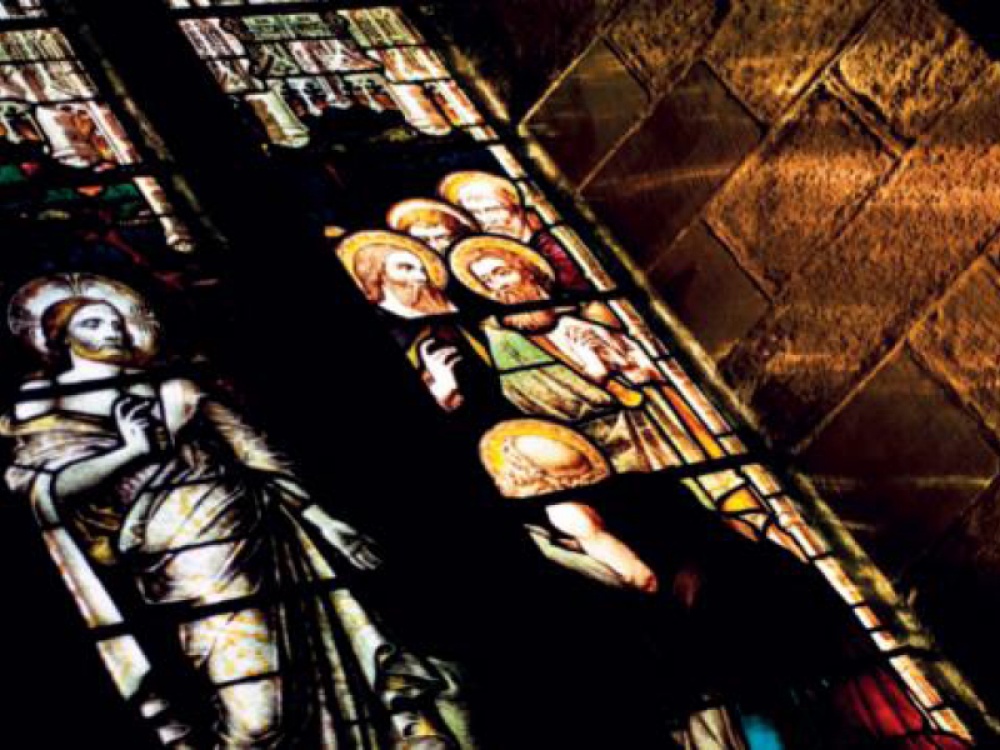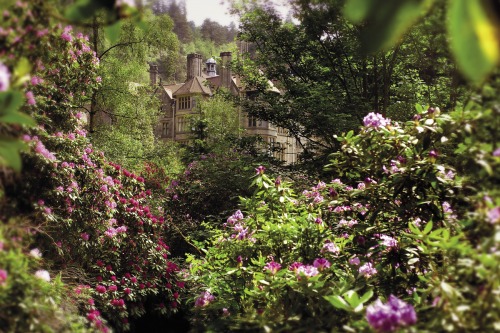Newcastle Cathedral Granted Funds to Bring the Building Back to Life

Towering majestically above the city’s skyline and adorned with sublime examples of craftsmanship, Newcastle Cathedral was part of the medieval core of the city: the cultural nucleus in which business was transacted, friends would meet and the city would come to worship. In what is now a challenging time for the Church in a more secular society, the Cathedral’s prominence within Newcastle’s civic life has ebbed – it has become a building many of us know embarrassingly little about and, more tellingly, feel somewhat disinclined to discover.
Now a £4.2 million National Lottery grant is set to change all that – hoping to propel Newcastle Cathedral into modernity by revitalising its age-old civic role and enabling it to reestablish itself as a dynamic hub for its local community.
‘Along with the castle and the market, Newcastle Cathedral was one of the foundations of the city,’ explains Catherine Mair, the Cathedral’s Marketing and Communications Manager. ‘Unlike other cathedrals (such as Durham, for example, which has a monastic heritage), Newcastle Cathedral used to be a parish church – the biggest in the city, in fact – which means that it has always played an important part in the day-to-day lives of its local community, and you can see that entire history with the names etched onto its walls. Newcastle Cathedral holds the story of the city in its very stones and monuments.’
And now the story continues. The funding awarded to Newcastle Cathedral’s exciting heritage project, Common Ground in Sacred Space, will be bolstered by additional funding from the Cathedral’s supporters, benefactors and charitable trusts to generate a total of around £6 million. A large slice of this will pay for physical changes inside and out: the removal of the pews; the installation of underfloor heating; the renewal of the Nave floor to create a more open and flexible events space; the landscaping of the south and east churchyards; and the transformation of the basement beneath the Cathedral’s hall to provide new staff, volunteer and visitor facilities – creating seven new paid positions and hoping to attract a minimum of 100 new volunteers in the process. It is hoped that these significant improvements will see the Cathedral reestablished as a key destination in Newcastle’s city centre.
‘Getting this award will enable us to turn a wonderful historic building into a stunning location and visitor destination,’ says the Very Reverend Geoff Miller, Dean of Newcastle. ‘It will help us to see what is under our noses but often overlooked. It will also offer an opportunity to encounter the diverse and fascinating people of the North in a unique way, as they bring the city’s history alive. We’re thrilled that The National Lottery Heritage Fund grant, together with our own generous funders, have made this a reality. In short, we’re massively excited and passionate about welcoming you all to your heritage.
It is the Cathedral’s capacity for being an appealing visitor attraction and events space that may surprise those of us who know little about its modern functionality. As well as its own concerts, public services and performances, Newcastle Cathedral has most notably hosted a special BBC preview screening of the 2017 Doctor Who Christmas Special, Living North’s own Awards ceremonies in 2015 and 2016 and, most recently, Sky Atlantic’s special screening of the Game of Thrones finale. A large part of this heritage project has thus been specifically designed to expand upon an events programme that welcomes all ages, abilities and beliefs into this uniquely atmospheric cultural space.
Read More: Celebrate Ripon Cathedral's 1350th Anniversary
‘We carried out a lot of market research before we applied for the grant, and not everyone we talked to even knew there was a cathedral in Newcastle,’ explains Kate Sussams, Director of Operations. ‘Of those that did, many raised questions such as: “Are we allowed in?” “What will I get from visiting? and “Will I get converted?” And that’s what we want to address with this project: we want to respond to the city, break down those barriers that stop people from visiting the Cathedral – particularly through our events programme – and champion the everyday inclusivity here that is actually quite rare. Newcastle Cathedral is fuelled by the belief that we are here to offer a welcome for all.’
But while the Cathedral offers itself up as a majestic arena in which to host independent events – one of only a handful of venues in the city that can easily host more than 400 people – its size is far from being its only asset. A significant part of the funding will also go towards creating imaginative ways of interpreting the unique civic, industrial and spiritual stories that the Cathedral encapsulates in its monuments, ledger stones (those commemorative slabs embedded into the floor), and stained-glass windows. Delving into the very fabric of the building with new and increasingly interactive activities, families, schools, community groups, and tourists will soon be able to enjoy an even more emotive heritage experience.
For Newcastle Cathedral is adorned with sublime examples of craftsmanship – from wood and stone carvings to beautiful stained-glass windows and alabaster effigies. Some of the most intricate work is the product of one of Newcastle’s foremost artists and woodcarvers, Ralph Hedley. Having studied under the pre-Raphaelite William Bell Scott, Ralph set up his own woodcarving and architectural sculpture workshop – regularly exhibiting at the Royal Academy in London, as well as producing lithographs for the local press and co-founding the Bewick Club, which encouraged and exhibited the work of North East artists.
Arguably his triumph of woodcarving, however, is the magnificent quire in Newcastle Cathedral. Created to mark the founding of the Diocese of Newcastle in 1882 (and the creation of Newcastle as a city), the quire was commissioned because of the new need for a cathedra, or Bishop’s throne – being the area of the Cathedral that provides seating for the clergy and choir. Ralph’s cathedra towers magnificently above the congregation, rising ‘towards the glory of God’ in a statement of intricate and exquisite decoration. It remains, to this day, the place where the Bishop of Newcastle sits during important services.
Read More: The Northumberland and Newcastle Society are Making Plans for their Centenary
Stretching further back into history, the striking Lantern Tower was constructed in 1448 and, being over 196ft (almost 60m) high, was for hundreds of years one of the main navigation aids for ships coming up the River Tyne. The magnificent Thornton Brass – thought to be the largest Flemish brass in the country – is an early 15th century memorial to Roger Thornton, three times Lord Mayor of Newcastle, who came to the city penniless and went on to become a successful merchant and a great benefactor of local churches. And the brass eagle lectern is the only pre-Reformation lectern in the North of England. Medieval treasures include the ornate font cover and a stained glass roundel of the Virgin Mary and infant Jesus, and a stone effigy of an unknown knight lies in the south transept; while no-one knows who he may have been, his crossed legs imply he may have fought in the Crusades, and the pattern on his shield suggests he may have been of the Scrope family, local lords in the 12th century.
Just as visitors will be welcomed to discover all of these treasures hidden in plain sight through the Common Ground in Sacred Space project, the renovation work being undertaken may also throw some new (or, rather, old) surprises into the mix.
‘We don’t actually know what the “original” church looked like,’ Kate reasons. ‘The earliest church on the site was probably constructed in around 1091 (not long after the stone castle was built next door), and it was the church of St Nicholas parish up until 1882, when it was bestowed cathedral status by Queen Victoria.
‘But the floor hasn’t been touched in centuries, so as we lift up these ledger stones we could possibly uncover, for the first time, what we believe will be the Norman foundations of the building. We’ll be allowing six archaeological digs with students from Durham University during the renovation, so it’s exciting to think about what we might find.’
The potential for further discoveries about the Cathedral’s (and, therefore, our city’s) heritage is undoubtedly thrilling, but the Common Ground in Sacred Space project is not solely working to open up the building’s historical assets to the public. The Cathedral is not a museum, despite its historical wealth, and the project will work hard to maintain a balance between developing the venue's appeal as a visitor attraction and protecting its primary function of being the ‘mother church’ for the Diocese of Newcastle. As well as being a place of quiet serenity in the heart of a vibrant city, it is the spiritual home of a caring, worshipping community; a refuge for victims of sexual and domestic violence; a place of active welcome to the LGBTQ+ community; and a sanctuary for the homeless that, rather than ‘processes’, offers them shelter, some food provision and a friendly ear.
‘This project will inspire people for generations,’ says the Right Reverend Christine Hardman, Bishop of Newcastle. ‘It is wonderful news for the whole of our Diocese that Newcastle Cathedral has been successful in securing this support from The National Lottery Heritage Fund. The funding will see the Cathedral greatly enhanced as a place of welcome and worship, and its presence in the city centre will be transformed. This further investment in the continuing development of Newcastle’s medieval quarter is creative and exciting for the city and for the Church.’
Read More: Discover the Perfect Coastal Shopping Spot in Northumberland
Welcome: this is perhaps the word that epitomises what Newcastle Cathedral offers now, and what its Common Ground in Sacred Space project hopes to encourage further by establishing the Cathedral, once more, as a relevant and, therefore, sustainable part of the cultural consciousness of the city. As I left this extraordinary building into the buzz of the busy city centre, I reflected not just on its majesty and craftsmanship, but on its place in Newcastle's history. It’s a building that can teach us so much, irrespective of any religious preconceptions, and with this financial support it will be fascinating to see how many more people from near and far will share in this by visiting it too.
What brings us together more than anything is often celebration, and by offering this ‘radical’ and increasingly accessible welcome to all, Newcastle Cathedral promises to be at the centre of a new age of celebration: celebrating the vibrancy of its own – and by extension, our – heritage; celebrating the (not exclusively Christian) community that it continues to serve; and celebrating the faith at its heart. Because while the space may be sacred, why shouldn’t it also be somewhere that we can all find some common ground?
Physical work on the Common Ground in Sacred Space project will begin early next year, with the launch of the redeveloped Cathedral and grounds planned for Easter 2021. For more information, visit www.stnicholascathedral.co.uk
10 quirky facts you may not know about Newcastle Cathedral
1 The first Bishop of Newcastle, Ernest Roland Wilberforce, was the grandson of William Wilberforce MP, who led the campaign against slavery in Britain.
2 St Nicholas is the patron saint of over 120 causes, including: children, archers, fishermen, shoe-shiners, pharmacists, poets and lace-makers. Most famously, he also became the model for Santa Claus because of his reputation for secret gift-giving.
3 The Cathedral is filled with hundreds of memorials to the city’s eminent individuals, many of whom wanted to be seen in life as well as in death. One such example, a memorial erected to his mother by one William Ingham, serves largely as an advertisement for his surgical services.
4 Another of the monuments inside the Cathedral is to Admiral Lord Collingwood, who was born on Side, Newcastle, and was both baptised and married in the church. His finest moment at sea came when he took full control of the British fleet during the Battle of Trafalgar in 1805, steering the fleet to victory after Nelson had been mortally wounded.
5 The Cathedral has hosted royalty over the years. In 1503, Princess Margaret (sister of the future Henry VIII), stopped here to worship on her way to marry King James IV of Scotland. King Charles I came here in 1646 during his ‘imprisonment’ at the nearby Anderson Place during the Scottish occupation of Newcastle in the English Civil War, reportedly arguing with the minister during church services. Most recently, Queen Elizabeth II dispensed Royal Maundy from the Cathedral in 1990.
6 Around the design of Ralph Hedley’s quire can be seen a whole host of incredible carvings, including angels (whose faces are said to have been modelled on his daughters), and a myriad of strange creatures in the canon’s stalls. Called misericords, the 26 seats in these stalls tip up (traditionally used to perch on if standing during services was too taxing for the clergy), and underneath each of them is an ornate, medieval-inspired creature: including griffins, wyverns, dragons and winged dogs.
7 One of the memorials on the walls is to John Bover, Captain in the Royal Navy, who was brought to Newcastle in 1763 to manage the ‘press gangs’ – those who carried out impressment, or the taking of men into a military or naval force by compulsion. The establishment thought he performed his task very well, as the plaque testifies, however this view was not entirely shared by the people of Newcastle.
8 In 1644, during the English Civil War, Scottish invaders badly damaged the church interior during a nine-week siege and threatened to bombard the Lantern Tower. The Lord Mayor of Newcastle, John Marley, called their bluff and imprisoned Scottish troops there – thereby ensuring the tower wasn’t blown up.
9 During the Second World War, Newcastle became home to the Danish Merchant Fleet after the fall of Denmark in 1940. Over 4,000 Danish seamen sailed from the River Tyne, with over 1,400 losing their lives in the conflict. The slate memorial at the east end of the Cathedral commemorates this history.
10 The Cathedral has the finest collection of ‘colours’, or regimental flags, anywhere in the country outside London. Being the ‘chapel’ of the Northumberland Fusiliers, when flags are renewed the old ones are displayed in the Cathedral in a special ‘laying up’ ceremony.









